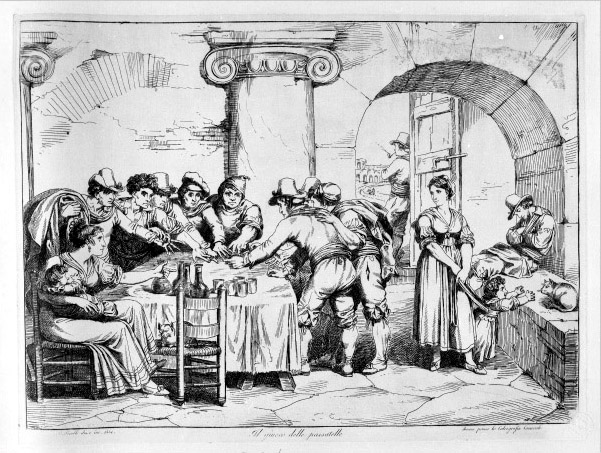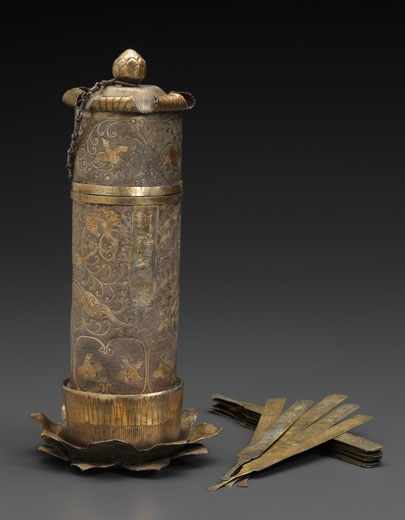In the past we’ve explored the history of two drinking games for adults, bocce and pétanque, and taught you how to play them. Both are great options, especially when the weather is nice outside, but today we’re going back through history to uncover six forgotten drinking games from around the world.
Kottabos – Ancient Greece

Ancient Greek symposia evoke images of antiquity’s great philosophers sipping wine from ornate cups debating life’s biggest questions. While some symposia were serious affairs others could revolve around Kottabos, a drinking game. Kottabos was a drinking game based around the athletic skill of tossing objects at a target. The primary objective was fairly straightforward: when all that remained in a player’s wine cup (a shallow bowl called a Kylix) were the dregs, he would hold the cup by one of its handles, swing it round, and fling the dregs at a target. The target was a small disc, which would be balanced atop a bronze stand. The goal was to knock the small disc off its stand with your wine’s dregs, so that it fell to a lower, larger platform. If the task sounds difficult enough, a player was expected to perform it from the reclined position one sat in at a symposium. Depending on the rules of the day, various prizes and penalties would be awarded for hitting or missing the mark.
A popular variation on the game – which sounds a bit like Quarters – replaced the solitary target with a number of saucers floating in a shallow bowl. The victorious player would be the man who sunk the most saucers, by landing his dregs in them.
Modern Option: As we said, Quarters, is similar, though far easier.
The Convivium – Ancient Rome

While a Roman convivium wasn’t exactly a drinking game, it did feature the key elements of any good drinking game: consumption of copious amounts of wine, rules, a way to ‘lose’ if you broke those rules, and consequences for losing. Here are the details: Like many Roman traditions, the convivium has its roots in Greece, in this case the aforementioned symposia. During a convivium, like a symposium, men would meet in the evening to drink wine and converse. While the Romans ran with both aspects, they focused a bit more heavily on the drinking. The evening’s host would settle on how many drinks each guest were to consume during the convivium, from one cup of wine to eleven cups. Whatever the number, each guest was expected to knock back each of those cups in a single shot. If you put down your cup before finishing a given round you wouldn’t be invited to the next convivium. As Ancient Rome’s leading citizens put on these events, getting yourself banished could harm your social standing.
Modern Option: All you need is a home and a host.
Passatella – Italy
Called ‘sadistic’ by some, this Southern Italian drinking game has its roots in the traditions of the convivium, but it’s quite different, with far different consequences for ‘losing.’ The game was played (or at times banned) throughout Italy for centuries. Passatella has many variations so we’ll stick to the basics:
- Eight to ten men would pitch in to buy drinks to be shared by all.
- A game, such as bocce, dice, cards, or morra (see below) was played to determine a padrone (the boss) and a sotto-padrone (the underboss).
- A round of drinks was ordered.
- The padrone drank the first glass, in a single gulp, and then offered the second glass to his sotto-padrone, who did the same.
- The padrone then began offering cups to the other men in the group, each of whom would have to ask the sotto-padrone for permission to drink. If granted, that man drank the cup, again, in a single gulp. This process typically involved insult-laden speeches explaining why or why not a given man was being offered (and granted or denied) a drink.

This would go on until the round was finished. A new game would be played to determine the next round’s padrone and sotto-padrone until everyone was good and drunk or a bit of violence broke out. As you can imagine, if the padrone and sotto-padrone weren’t equitable in doling out drinks, as some men got drunk, and others suffered through the rounds soberly, the insults and reactions could escalate. As the rounds went on, if certain men kept being denied (drinks for which they chipped in money!), well, that’s when the game turned ‘sadistic’ if common folklore is to be believed. Vengeance is said to have often involved knifings, which, given the game’s not-so-subtle allusions to the Mafia, isn’t entirely unbelievable.
Modern Option: Stick to bocce and stay safe.
Two Drinking Games From Tang Dynasty China
According to Charles D. Benn’s Daily Life in Traditional China: The Tang Dynasty, things got competitive when patricians gathered to drink. As in Ancient Roman and Greek times, these drinking games played a key role in society, especially for the well to do. A number of games were popular. Here are two of our favorites:
The first game, which mimics the basic principle of Spin The Bottle, we’ll call ‘Spin The Barbarian.’ The host, a guest, or a courtesan, would spin a carved top, designed to look like a “Western Barbarian.” Whomever the barbarian pointed at when it came to a stop was required to knock back all the ale in his goblet.

The second game is actually a family of games, which Benn refers to as the Ale Rules. A silver canister would be filled with oar-shaped lots, which players would draw in turn. The lots were inscribed with various drinking instructions, along with a varying measure of ale to be knocked back by whomever was the target of a given instruction. Those instructions designated drinkers ranging from the puller of the lot to more creative ideas such as:
- The highest-ranking official present
- The youngest guest present
- The event’s most talkative guest
- The drinker with the greatest reputation for holding his ale
- A blank, free pass
Given the subjective nature of some of those commands, as well as the prospect of drunken guests violating the rules, three officials were designated to keep everyone honest:
- The Governor – Someone who reviewed penalties.
- The Registrar Of The Rules – Someone who knew the rules well and called out violations.
- The Registrar Of The Horn – Someone who dealt with repeat offenders.
A typical scenario went like this: When a guest grew too rowdy, got up (to flee the game!), or committed some other violation, the Registrar Of The Rules called him out by throwing down a lot. The offender would acknowledge he’d broken a rule and knock back ale from the penalty goblet. If a particular guest (we all know one) continued to flout the rules, the Registrar Of The Horn would throw down a silver flag. The guest would once again admit his error and down another cup of penalty ale. After a third fine the Governor would intervene, review the case, and deal with the offender if he decided he had committed three infractions. As the goal was to get everyone boisterously drunk, but under control (i.e., the opposite of Passatella), penalties could be quite steep. And those who failed to make good on the penalties? Like the Romans, banishment from future games was always on the table.
Modern Options: Dreidel With Booze & Kings
Guzzling From The Puzzle Jug – France & England
A puzzle jug is a ceramic drinking vessel thought to have originated in fourteenth century France. The jug, which was perforated with numerous holes in its neck, was obviously quite difficult to drink out of without spilling wine all over oneself. The jug was a puzzle though, so each jug had its own solution. If a drinker/player sucked on the spout, and covered up the right holes, suction would be created, allowing the puzzle jug’s contents to safely flow through a hidden tube without spilling. Puzzle jugs were difficult for even sober players to master, so attempts almost always resulted in spills; as you can imagine they were a great source of tavern entertainment. They spread to Britain, where they remained popular through the nineteenth century.
Watch a potter make a puzzle jug:
Modern Option: Sounds like a great DIY project!

